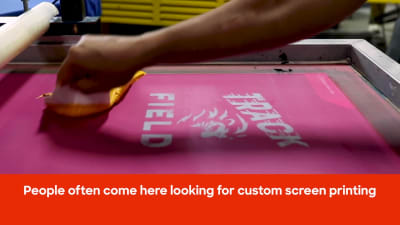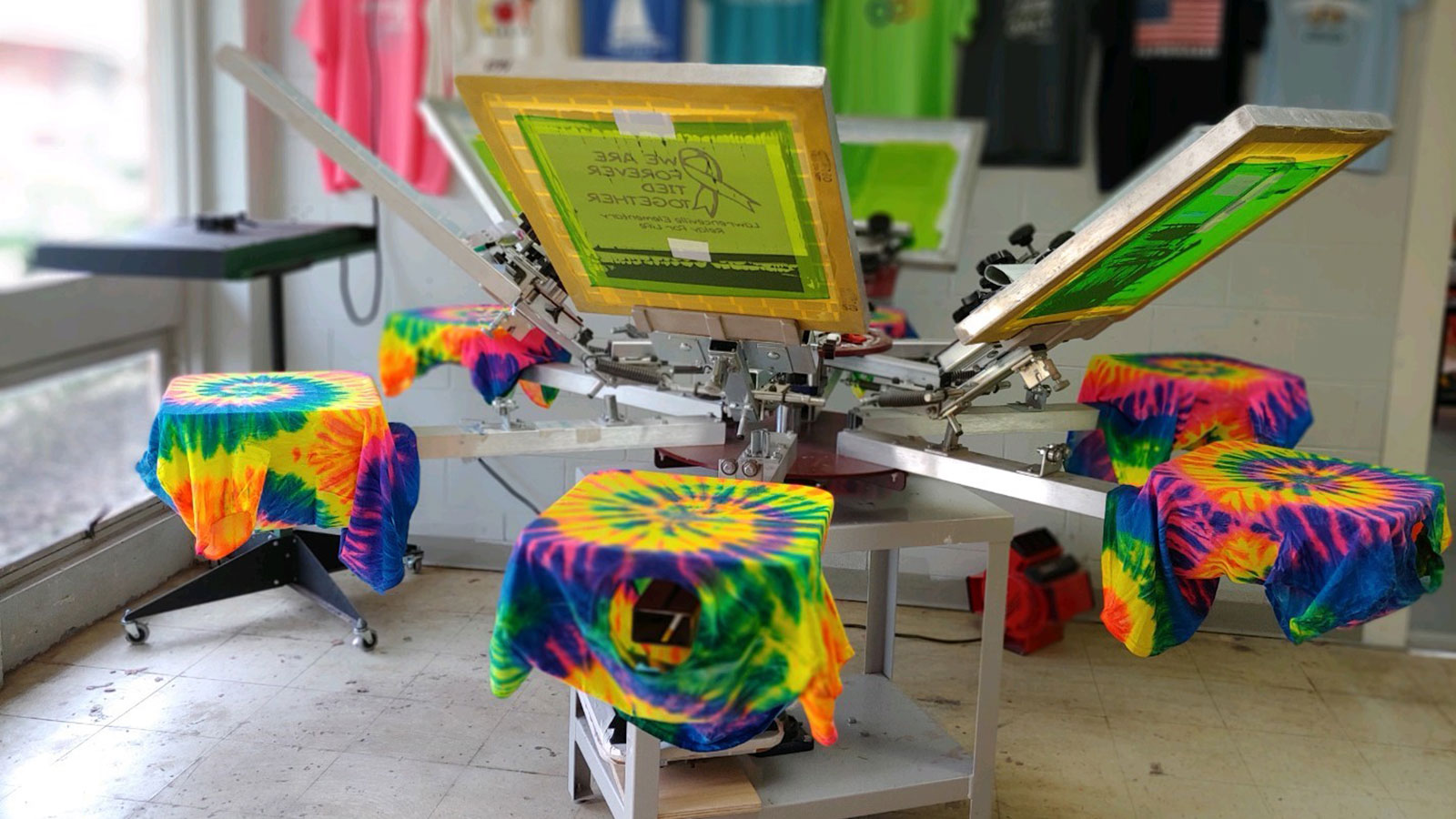Display Printing Uncovered: Every Little Thing You Required to Know Concerning T-Shirt and Garment Printing Methods
If you've ever questioned just how those vibrant designs wind up on your favorite tee shirts, you remain in the ideal location. Screen printing is a fascinating method that integrates art with strategy, using limitless opportunities for creativity. Understanding the principles, from equipment to ink choices, can greatly impact your results. Prepared to check out the essential elements that make screen printing an art form? Allow's discover the details that can boost your tasks.
The Fundamentals of Screen Printing: Exactly How It Works
When you dive into screen printing, you'll find it's both an art and a science. At its core, screen printing entails developing a pattern, or screen, that enables ink to pass through only in specific locations (screen printing kit). You start by selecting your style and preparing your screen with a light-sensitive solution. When you expose this solution to light, it solidifies, leaving your layout as an unfavorable room.
Setting the display over the fabric, then utilize a squeegee to press ink through the screen onto the garment. Each step is crucial, and mastering them will certainly elevate your screen printing skills, transforming straightforward garments into distinct, meaningful items.
Sorts Of Screen Printing Techniques
When you comprehend the fundamentals of screen printing, it's time to check out the different methods that can elevate your designs. One preferred method is conventional screen printing, where ink is pressed with a stenciled screen.
Another choice is plastisol printing, known for its durability and dazzling shades, making it a favorite for several brands. Experiment with halftone printing to develop gradient results and elaborate layouts.
Necessary Equipment for Screen Printing
To attain spectacular results in display printing, having the best equipment is fundamental. You'll require a tough display printing framework, which holds the mesh that transfers your design onto the garment. Next off, invest in top quality squeegees; these are crucial for using ink equally across the display.
Choosing the Right Inks and Materials
When choosing inks and materials for display printing, you need to take into consideration the sort of ink that works best for your project. Consider fabric compatibility to assure your layouts look terrific and last long. Explore eco-friendly ink options to make your printing process much more sustainable.
Kinds of Screen Inks
Selecting the right display ink is vital for attaining dynamic, long lasting prints that satisfy your task's needs. There are a number of sorts of screen inks to analyze. Plastisol ink is preferred for its flexibility and simplicity of use, giving exceptional color opacity on dark textiles. Water-based ink, on the other hand, supplies a softer feeling and is eco-friendly, making it perfect for those wanting to reduce their environmental impact. Discharge inks remove color from the textile, leading to a soft, classic appearance however need certain handling. Ultimately, specialty inks, such as glow-in-the-dark or metal, can include one-of-a-kind results to your layouts. Evaluate your job requirements and choose the ink that aligns best with your wanted result.

Textile Compatibility Factors To Consider
Comprehending fabric compatibility is essential for attaining high-grade screen prints, especially considering that different products react distinctly to various inks. Constantly evaluate your inks on example fabric to ensure they stick appropriately and preserve shade integrity. Furthermore, maintain in mind that fabric weight and appearance can affect the last end result, so selecting the ideal ink and material combo is essential for your project's success.
Eco-Friendly Ink Options
Environment-friendly inks are coming to be a preferred selection for screen printers that desire to decrease their ecological impact while preserving quality. When selecting inks, consider water-based inks, which are less damaging and less complicated to cleanse up contrasted to standard solvents.
Furthermore, seek inks made from renewable energies, such as soy or vegetable-based alternatives. By selecting the ideal inks and products, you'll not just produce stunning designs but also contribute to an extra lasting printing process. this article Make the switch, and your prints will reflect your dedication to the atmosphere!
Preparing Your Style for Screen Printing

Submit Format Demands
To assure your layout looks vibrant and sharp on material, you'll need to pay close attention to file layout requirements for screen printing. Make sure your design has a clear history to prevent undesirable white sides on your prints. Maintain shade modes in mind; CMYK is typical for screen printing, so convert your RGB creates appropriately.
Color Separation Techniques
Shade splitting up is a crucial action in preparing your design for display printing, and grasping it can significantly boost your print high quality. You'll need to damage your design into specific shades, as each color needs a different screen throughout printing. This accuracy not just guarantees precise shade representation however also improves the printing procedure.
Resolution and Dimension
Achieving the ideal outcomes in screen printing starts with assuring your style has the best resolution and dimension. Ideally, your artwork needs to go to least 300 DPI (dots per inch) for sharp, clear prints. If you make use of lower resolution, your final item might look pixelated and amateur.
When it concerns size, take into consideration the measurements of your print area. Layout your art work to match the final print size, ideally producing it in the real measurements you'll be printing. By doing this, you'll avoid any unanticipated scaling concerns.
Always check your style in both vector and raster styles. Vector graphics can read more be scaled without shedding top quality, making them ideal for screen printing. Preparing properly will ensure your layout looks incredible on every garment!
Step-by-Step Screen Printing Process
Display printing is a vibrant procedure that allows you to create dynamic designs on different surface areas. To obtain begun, you'll require a display, emulsion, and your selected ink. Initially, prepare your display by cleansing it extensively. Next off, use the solution equally and let it dry in a dark location. Once dry, expose your screen to light with your design positioned on it, which will certainly set the solution where the light hits, creating a pattern - screen printing kit.
After rinsing the unexposed solution, your screen is ready. Establish it up on your printing surface area and straighten your garment under it. Put ink onto the screen and make use of a squeegee to press the ink with the stencil onto the fabric. Raise the display very carefully and allow the print dry. Finally, cure the ink using warmth to ensure resilience. That's it! You've successfully display printed your design.
Tips for Effective Screen Printing Projects
While you're diving right into your display printing jobs, remember that preparation is vital to success. Beginning by gathering all your products-- inks, displays, garments, and squeegees. A clean office helps protect against undesirable errors, so neat up before you start.
Following, verify your art work is high-resolution and correctly sized for your garment. Examine your display for proper direct exposure and clean it extensively to prevent spots. When mixing your inks, comply with the supplier's standards to attain the appropriate uniformity.
Throughout printing, apply even pressure with your squeegee for consistent outcomes. Do not hurry; take your time to verify each print pop over to this web-site meets your requirements. After printing, let your garments dry completely prior to managing or packaging them.
Lastly, constantly keep an example of your benefit future reference. By doing this, you can evaluate your progression and improve your strategies in time. Satisfied printing!

Frequently Asked Inquiries
The length of time Does It Take to Establish up a Screen Printing Task?
Establishing a display printing work generally takes about thirty minutes to an hour. You'll prepare the screens, mix inks, and readjust journalism. The time differs based upon intricacy and experience, so stay organized!
Can I Print on Different Textile Keys In Making Use Of the Very Same Method?
Yes, you can publish on various textile kinds utilizing the same technique, however you'll need to readjust your inks and settings. Some materials take in ink in different ways, so trying out assurances the most effective results for every product.
What Prevail Blunders to Prevent in Display Printing?
When screen printing, stay clear of typical mistakes like utilizing the incorrect ink, neglecting appropriate exposure times, or avoiding pre-press checks. Constantly evaluate your setup and preserve tidy displays to guarantee high quality results each time.
Exactly How Can I Correctly Clean and Preserve My Screen Printing Tools?
To correctly tidy and preserve your display printing devices, you should frequently clean screens with suitable solvents, inspect squeegees for wear, and guarantee all devices are saved dry and dust-free. Uniformity boosts and protects against costly repairs efficiency.
Is Screen Printing Eco-friendly Contrasted to Other Techniques?
Screen printing can be more environmentally pleasant than other methods, particularly if you make use of eco-conscious materials and water-based inks. By choosing lasting supplies and methods, you reduce waste and minimize your influence on the world.
Screen Printing Uncovered: Everything You Required to Know Concerning Tee Shirt and Garment Printing Methods
At its core, display printing includes developing a pattern, or screen, that allows ink to pass with just in details locations. Position the screen over the material, then make use of a squeegee to press ink through the display onto the garment. One prominent approach is traditional display printing, where ink is pressed through a stenciled screen.When picking inks and products for display printing, you require to take into account the type of ink that works finest for your project.